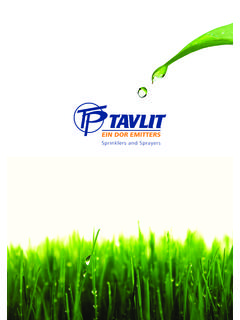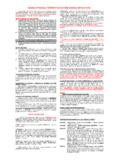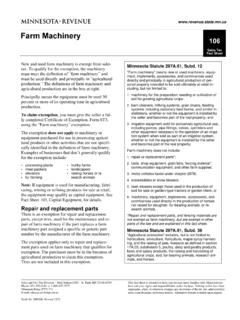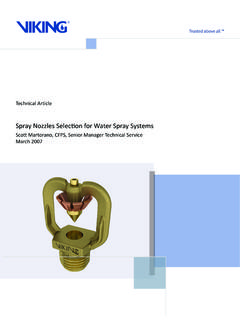Transcription of Working safely near overhead electricity power lines AIS8
1 1 of 4 pagesHealth and Safety ExecutiveHealth and Safety ExecutiveAgriculture Information Sheet No 8 HSE information sheetWorking safely near overhead electricity power linesIntroduction This information sheet is aimed at everyone in agriculture who may work near overhead electricity power lines (OHPLs) and outlines what you can do to reduce the risks of electric shock when Working near them. If a machine or other conductive item of equipment comes into contact with a live OHPL, electricity will be conducted through it to earth. You do not need to touch the line, as in some circumstances electricity can flashover or arc (it can jump across gaps). Anyone touching a machine or equipment in these circumstances risks a serious or fatal electric shock.
2 HazardsOHPLs typically carry electricity at voltages from 11 kV to 400 kV. The lines are often uninsulated (bare) cables. Touching anything in contact with live electrical equipment (even at the lowest voltage) can be fatal. The height of the line varies according to the voltage carried (see Figure 1) so for example any 11 kV or 33 kV OHPL on your land should be at least m above the ground. Electrical equipment mounted on poles may be lower than the clearances specified in this guidance. Although the minimum heights of OHPLs may be adequate for most work activities, there are many agricultural machines that are capable of reaching or touching OHPLs or pole-mounted equipment, including:rough terrain fork lift trucks and telescopic materials handlers;combine harvesters; self-propelled harvesters, eg forage harvesters, beet harvesters etc;crop sprayers; tractors and tractor-mounted fore end loaders.
3 Remember that the overall height of a machine may be increased by fitting radio aerials, flashing beacons or in the case of combine harvesters, when the discharge auger or grain tank extensions are machines often used in agriculture are capable of reaching an OHPL, including:construction plant, such as excavators or diggers; goods vehicles with tipping bodies or trailers; lorry-mounted or self-propelled cranes or grabs. 275 or 400 kV132 kV33 kV11 kVLow voltageOpen combine grain tank lids/unloading augers can exceed mTelescopic materials handlers can exceed mMinimum height 7 m (275 kV) and minimum height m (400 kV)Minimum height mMinimum height mFigure 1 Minimum heights above ground level for overhead power lines2 of 4 pagesHealth and Safety ExecutiveSome agricultural activities may also create a risk of contacting OHPLs, including:operating rain or slurry guns; tipping trailers; moving irrigation pipes or long boom irrigators; building temporary stacks or structures, eg bales, fertiliser, potato boxes; moving aluminium ladders or scaffold poles; construction work including erecting steel-framed buildings.
4 Erecting polytunnels and temporary structures; fishing ( electricity can pass through rods/poles). Working safely : Assessing the risksBefore you start work near OHPLs, you should assess the risks. To help do this you should:find out the maximum height and maximum vertical reach of your own and your contractors machines;find out the routes of all OHPLs on your land or near your boundaries and mark them on the farm map;make sure you have information about all the lines on your land if not, contact their owners;make sure you have details of the maximum Working heights permitted under each span of OHPL on your farm and next to each structure. Record these on the farm map. The map can then be used as a reference when assessing risks, planning cropping or other work, instructing machine operators and contractors, planning access routes or buying new or used equipment;get advice from the electricity distribution network operator (DNO) and/or the National Grid on line heights, minimum vertical clearance distances and precautions to take.
5 DNOs can also arrange to have the height of the lines checked. Operating voltages are displayed on signs attached to steel towers;look at the guidance produced by the Energy Networks Association on clearance distances (see Further reading ). Control measuresWhen considering what you need to do to work safely , you should follow the preferred hierarchy of measures described below:The safest option is always to avoid Working near OHPLs if you can. Creating alternative access routes or work areas to avoid OHPLs is often the easiest and cheapest re-routing or burying OHPLs in certain locations, such as farmyards or silage clamps where machines often pass below the lines . Consult the DNO for advice and do not attempt to do this work yourself.
6 Where you cannot relocate OHPLs, select machines that can safely pass below the lines without being able to reach the vertical clearance some short duration work activities you may be able to get the power supply switched off. Speak to the DNO for you cannot avoid Working near OHPLs, you will need to carry out a risk assessment and implement a safe system of work. Key factors to consider for safe work near OHPLsSelecting suitable machineryLarger farm machinery has increased the risks of contacting OHPLs. You can reduce the risks of contact or flashover greatly by selecting machinery that will not reach more than 4 m from the ground. Check the Working heights of machines and the maximum heights that any folding or extending elements can reach.
7 Check with the manufacturer or supplier if necessary to obtain these details and check these heights against the clearances marked on the farm map to identify areas of risk. Consider line heights when you buy new or replacement use of machinery and equipmentMoving equipment or machinery when extensions are raised could bring it into contact with OHPLs. Reduce risks by making sure machines can operate safely near OHPLs. For example:retract the booms of telescopic handlers and keep them close to the ground when the vehicle is moving;lower grain tank lids and ensure that unloading augers on combines are stowed and not in the extended/unloading position;use sprayers with horizontally folding booms and never fold vertical sprayer booms on the move;fit shorter radio aerials and beacons, reposition or remove existing ones on high machines, so they cannot cause danger;take care not to damage poles and stays.
8 Remember that risks increase at dusk, in darkness or in poor visibility when it becomes harder for machine operators to see of 4 pagesHealth and Safety ExecutiveSafe work activitiesRisks can be reduced if the following activities are not carried out within a horizontal distance of at least 10 m from OHPLs. These distances should be measured from the line of the nearest conductor to the work, projected vertically downwards onto the floor, and perpendicular to the route of the line (see Figure 2). The activities are: stacking materials, eg bales, fertiliser bags or potato boxes etc;erecting temporary structures, eg polytunnels; folding sprayer booms; tipping trailers or lorries with tipping bodies; operating materials handlers or lift trucks; Working on top of combines or other high machinery;moving ladders, irrigation pipes or scaffolding; tree work.
9 If you cannot avoid carrying out any of these work activities closer than 10 m, consult your DNO for advice. If the line cannot be moved or made dead you will need to assess the risks and agree a safe system of work. This may involve the erection of barriers to keep machinery a safe distance away from OHPLs, and other precautions as described in the HSE guidance note Avoidance of danger from overhead electric power lines (see Further reading ).Rain and slurry gunsPosition rain and slurry guns so that jets of water or slurry cannot contact OHPLs when they are in use. Guns should travel parallel to OHPLs, not below that jet breaker devices are Working , as a continuous jet in contact with an OHPL could cause the equipment to become guns should not come within 30 m of an OHPL and this distance should be increased in high winds to take account of slurry being carried further by the boom irrigatorsWhen a machine is being moved or used, keep it under close observation and should have a nylon or polypropylene control rope at each a boom is assembled or dismantled on site this should be done at least 10 m away from that the jets are not near OHPLs and that jet breaker devices are fitted and not store pipes under or close to OHPLs.
10 Always move irrigation pipes horizontally, using two people to carry them as low as the layout of the system carefully, so risks are minimised when putting pipes in fencing wire is being stretched, it could spring upwards and come into contact with OHPLs, so always keep the wire under runs of wire on undulating ground or hillsides present an increased risk, so anchor the fence securely at several and temporary structuresBefore building a stack or other temporary structure, plan where to locate it to avoid OHPLs. Do not site them in areas where machines such as telescopic handlers will need to travel underneath OHPLs to get to creating clamps below OHPLs, as vehicles rolling the clamp or trailers tipping grass etc will be at or bins should be sited so bulk feed delivery vehicles or trailers can tip workThere may be occasions when construction work has to be carried out, eg erecting farm buildings, excavation work for laying pipes etc which means machines or vehicles pass near OHPLs.

















